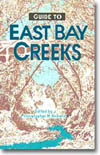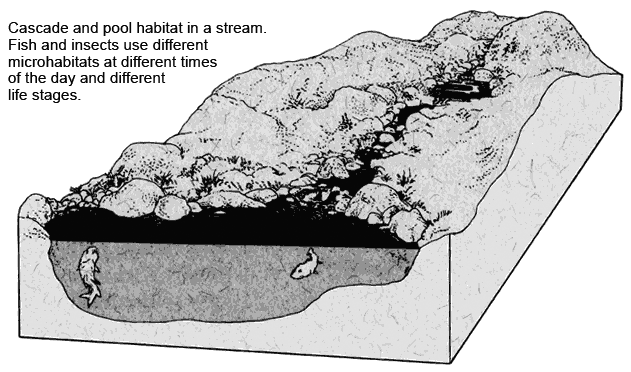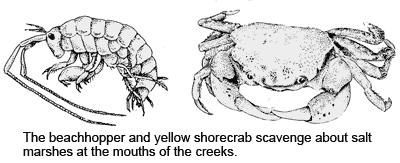GUIDE TO EAST BAY CREEKS
Chapter Three
Biology & Ecology
 Just as creeks organize the East Bay's physical landscape, they also are vital for much of its plant and animal life. Within creeks and along their edges a variety of creatures make their homes. They depend upon one another, upon the streamside plants, and upon the creek itself for food and shelter.
Just as creeks organize the East Bay's physical landscape, they also are vital for much of its plant and animal life. Within creeks and along their edges a variety of creatures make their homes. They depend upon one another, upon the streamside plants, and upon the creek itself for food and shelter.
The dynamic, interwoven elements of a creek system support a richly diverse network of life. It starts with the nature of the streambed and the seasonal changes in water flow. Streamside plants provide food for insects, which in turn are food for fish, which nourish streamside predators from birds to large mammals — including people.
Within a creek the speed of the current, temperature, amount of oxygen, nutrient levels, and the nature of the bottom all influence the aquatic life. In a creek's headwaters the water flows down a steep grade. Riffles — current cascading over shallow rocky stretches — alternate with pools in deeper areas.
Riffles are critically important to the aquatic food web because they support a variety of life. The splashing water becomes highly oxygenated, and the rocks provide surface area that insects cling to and hide under. Moreover, any loose food items drift along past predatory fish waiting in the eddies.

The deeper, quieter pools offer different amenities. They provide a place to hide from predators. In some, the deeper water is cooler — an important concern for fish on a warm East Bay afternoon. Because the current is slower, the fish don't have such a struggle staying in one place. But that also means fewer insects float by for fish to eat.
Part of what makes creeks so rich is the interaction of life in the stream with life on the banks. Just as the freshwater habitat varies with altitude and current, so too do the plants and animals that inhabit the adjacent banks and draw sustenance from the water.
The trees and plants depend upon the creek's water supply, but they also support the living system. Their roots stabilize the banks against erosion. Their leaves and branches fall into the water and provide nutrients for insects, and they provide cooling shade and cover for deer, raccoons, squirrels, opossums, and skunks. Snakes, salamanders, and frogs use both the banks and the water at various stages of their life cycles. Birds, too, depend upon the creeks for survival. The creekside woods are full of thrushes, sparrows, flycatchers, finches, and wrens, to name a few. Nearer the water, you can still observe kingfishers, herons, bitterns, cormorants, and ducks.
Because of the interrelated nature of creekside and aquatic organisms, and the feedback mechanisms between upstream and downstream conditions, disruptions in a creek's natural course disturb the inhabitants' lives. A healthy creek is a continuous system, not a collection of individual sites. If a creek is intermittently buried in a culvert, the burial disrupts the stream system and can have a magnified impact on ecological diversity. Mammals, for example, can't range up and down the banks, so that even those areas that appear natural tend to be thinly populated. Likewise, most fish are mobile, moving upstream or downstream to feed or reproduce. Such movement is important in maintaining many different species. But the urban creek habitat has been chopped into small chunks. For instance, on Strawberry Creek, which once supported a thriving steelhead population, 28 check dams obstruct the creek on the University of California campus alone. Downstream, the creek is separated from the Bay by two miles of culvert.

In the East Bay we have more often preserved upstream portions of creeks. Though they may look beautiful, they aren't necessarily functioning ecologically the way they once did. The upper reaches of certain creeks once were thick with virgin redwood and bay trees, giving way in the lower reaches to willows and buckeyes. Other headwaters were shaded by oaks, bays, and maples. Stories from the last century describe dense clumps of strawberries, blackberries, and huckleberries, masses of ferns, nettles, and wild cucumber vines, which can still be found in the protected headwaters of some East Bay creeks.
One hundred and fifty years of logging and construction throughout the hills caused an ongoing erosion problem, sending far more sediment into the creeks than they can easily carry downstream. The sediment silts over life-sustaining gravels, eliminating the places fish lay their eggs and habitat for insects. Leaking sewers and pesticide runoff take an additional toll on creek life. Streamside plant communities are radically altered, largely due to the dumping of garden clippings.
In the flatlands, East Bay creeks are now almost completely buried or channelized. Those portions that remain uncovered have been so altered by upstream and downstream development that we must make educated guesses about how they once looked and functioned ecologically. Certainly, as the streambed gradient flattened, the creeks spread out, with root wads from trees providing cover and directing stream flows. Different fish and insects inhabited the warmer waters.

Tidal marshes, which occurred where the streams met the Bay, were an integral part of East Bay streams. These protected, still waters were nutrient rich, the settling ground for all that the stream transported. Varying degrees of salinity provided diverse habitats. Marshes were nurseries for many marine animals. For other species, marshes provided lifelong habitat.
Historically, East Bay marshes supported plentiful beds of mussels, oysters, clams, crabs, and shrimp, which in turn drew waterfowl and shorebirds in huge numbers. The shores of San Francisco Bay were one of the most important stopping points for millions of birds migrating along the Pacific Flyway. Dredging and filling have eliminated all but a minute remnant of these marshes.
--Sarah Pollock & Christopher Richard
Chapter 2 Chapter 4
Top of PageTable of ContentsGlossary |